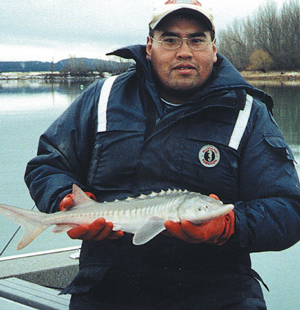Biologists monitoring
impact of high flows on sturgeon
|
|
July 19, 2011 |
 |
|
A Kootenai
Tribal Hatchery technician shows a young
Kootenai River White Sturgeon ready for
release. |
While Libby Dam operators were able to keep
flooding at bay in Bonners Ferry this year, the
extraordinary runoff on the Kootenai River
presented a new and different environment for
white sturgeon spawing.
The U.S. Army Corps of Engineers operated the
dam for pure flood control purposes this year, a
change from past years when flows and
temperatures have been adjusted in efforts to
test and improve sturgeon spawning conditions.
This year, the dam was scheduled to conduct a
spill test, releasing water over the spillway to
boost flows so as to coax sturgeon into moving
into prime spawning habitat in the stretch of
river known as "the braided reach" just upstream
from Bonners Ferry.
Unprecedented low elevation snowpack feeding
Kootenai River tributaries led to high flows for
weeks on the river, requiring restraint on the
part of Libby Dam operators and negating the
need for the spill test.
"The main thing was to keep Bonners Ferry from
getting wet," said Brian Martoz, a Montana Fish,
Wildlife and Parks biologist and a member of the
interagency White Sturgeon Recover Team. "Just
the way it came off, the water was just below
flood stage at Bonners Ferry and stayed there
for a month, and that allowed us to achieve the
conditions that the spill test was going to
produce without actually having to spill."
But the sheer duration of high flows was a bit
different than a spill would have produced, and
there were sustained cold water temperatures in
the river, different conditions than sturgeon
have experienced with the Libby Dam went in in
the late 1970s. There hasn't been a detectably
successful sturgeon spawn since.
Idaho Fish and Game biologist Pete Rust and
others have been watching whether this years'
unusual conditions have a noticeable affect.
"The spawning season was a bit delayed," he
said, noting that the first eggs collected on
adhesive mats in the river bottom didn't appear
until May 31, when they're usually picked up in
the middle of May. Even with the delayed season,
though, Rust said he anticipated that more
spawners would move in the the brtaided reach
than in other years.
But only four female sturgeon tagged with
transmitters were detected moving into the
reach, down from six last year. This year 28
fish were tagged and monitored, whereas last
year there were 36 fish, which may account for
the difference, as well as the very length of
time the water ran high.
"If you have high, cold, dirty water, it's hard
to catch them, and that's what we had for
awhile," Rust said. |
|
Questions or comments? Click
here to
email! |
|
|

